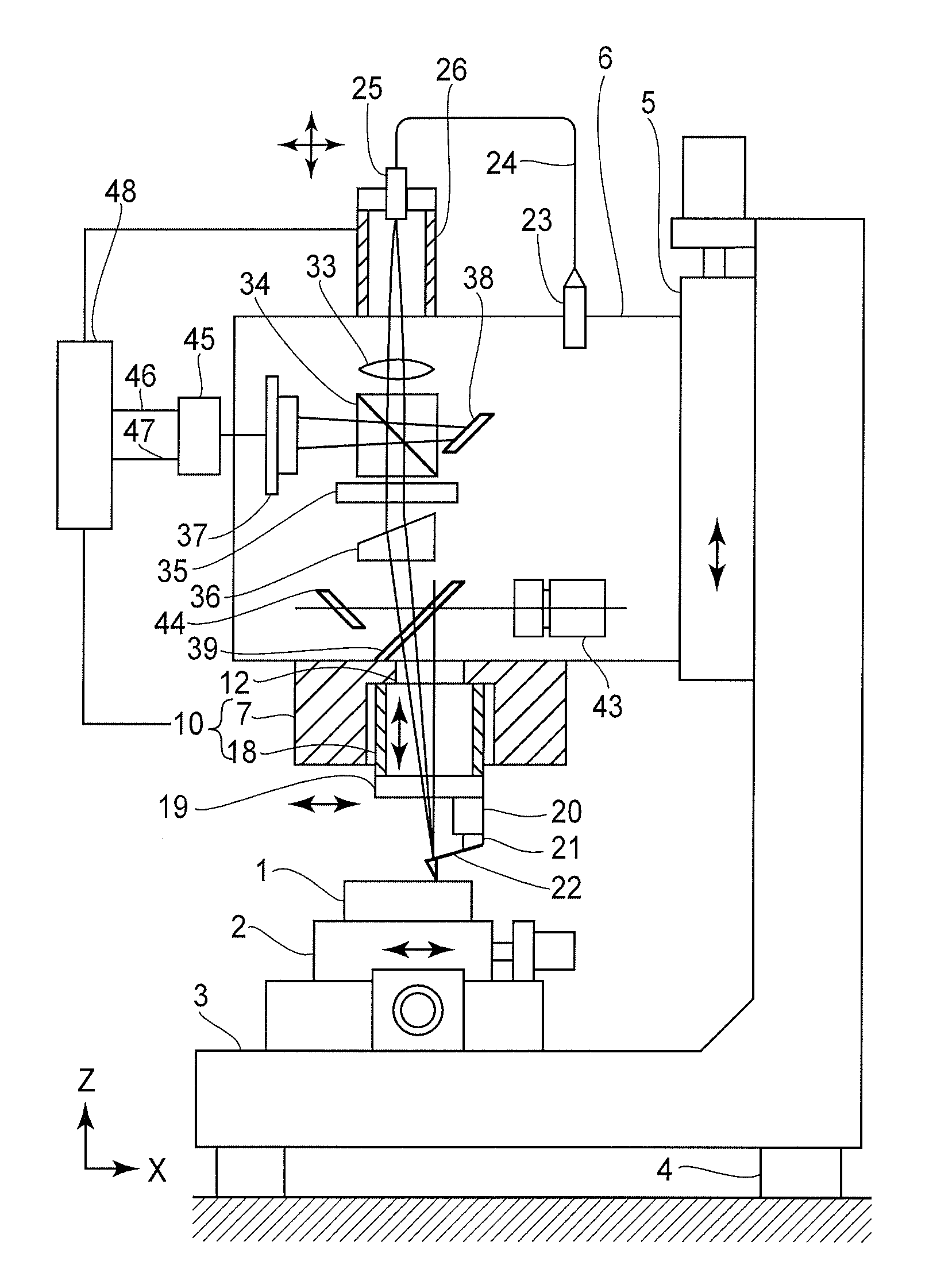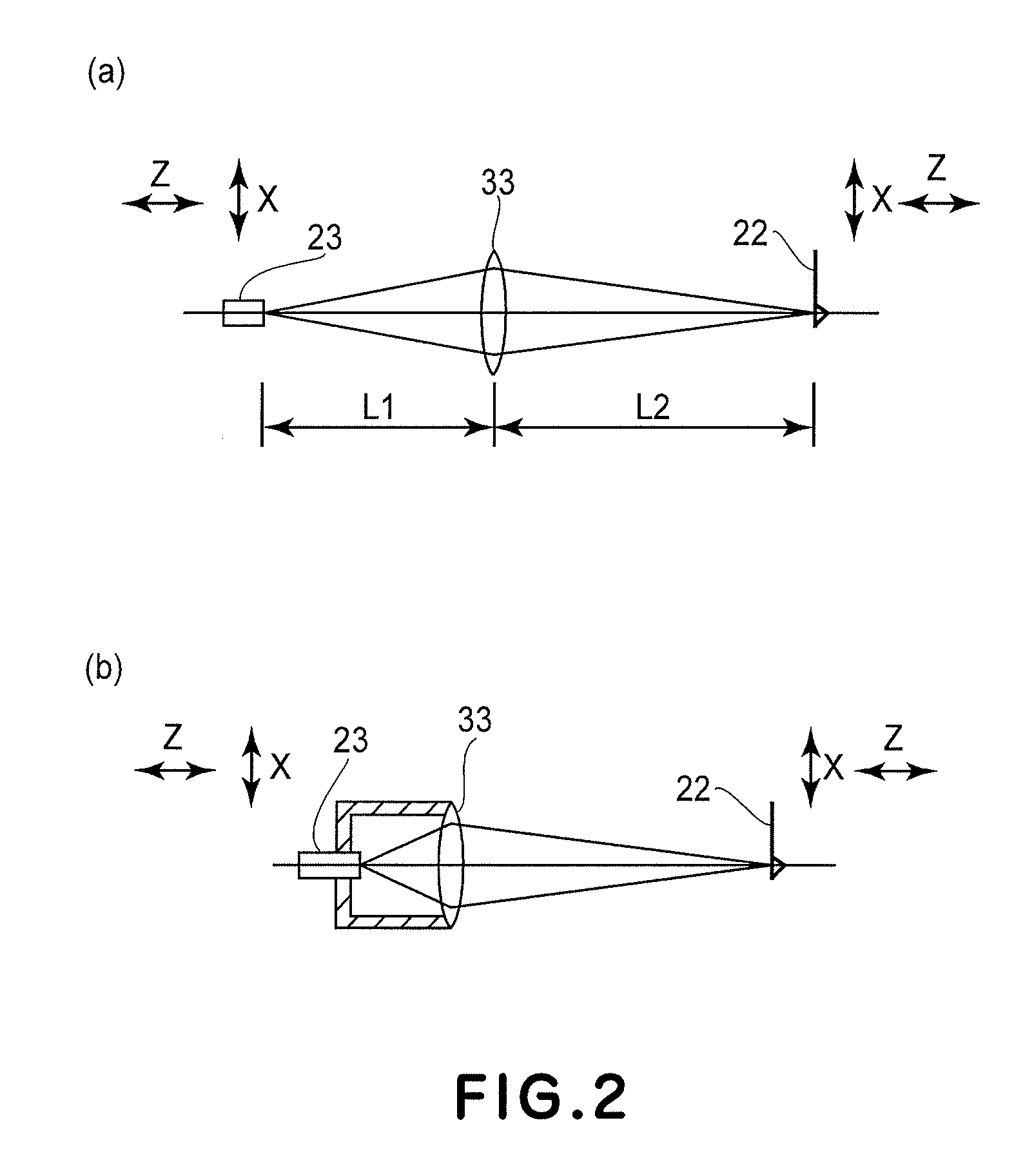Atomic force microscope
a microscope and atomic force technology, applied in the direction of mechanical measurement arrangements, mechanical roughness/irregularity measurements, instruments, etc., can solve the problems of reducing measurement accuracy, causing a pattern deviation between a probe and the focus of an optical system, and unable to effect high-accuracy measurement. achieve the effect of high accuracy
- Summary
- Abstract
- Description
- Claims
- Application Information
AI Technical Summary
Benefits of technology
Problems solved by technology
Method used
Image
Examples
embodiment 1
[0079]FIG. 1 shows an atomic force microscope according to Embodiment 1. A base 3 is disposed on a vibration isolation stand 4 and on the base 3, an XY coarse movement stage 2 is disposed. On the XY coarse movement stage 2, a member 1 to be measured is set. To a Z coarse movement stage 5 provided vertically to the base 3, a housing 6 is provided. The housing 6 holds an XY scanner 7 movable in X and Y directions.
[0080]FIG. 3 is a schematic view of the XY scanner 7 as seen from above (Z direction). A main assembly of the XY scanner 7 has a hinge mechanism cut from a metal material and is provided with four X plate spring portions 8 formed by wire cut processing, so that an X movement portion 9 is movably guided in X direction. In the X movement portion 9, an XY movement portion 10a is provided and guided by four Y plate spring portions 11. By this constitution, the XY movement portion 10a is movably guided in X and Y directions. At a center of the XY movement portion 10a, a through ho...
embodiment 2
[0162]FIG. 11 illustrates an atomic force microscope according to Embodiment 2. The atomic force microscope of this embodiment has the same constitution as that of the atomic force microscope of Embodiment 1 except that an auto focus apparatus is incorporated in an optical path of reflected light from the probe 22.
[0163]The auto focus apparatus is fixed to the housing and includes a half mirror 58, a lens 59, a cylindrical lens 61, and a four-piece photodiode 62.
[0164]Light reflected by the probe 22 is diffusive light since focus thereof is placed on the probe 22. The light is reflected by the beam splitter 34 and enters the half mirror 58. The transmitted light enters the light detection means 37 and the reflected light is converted into light converged by the lens 59 and passes through the cylindrical lens 61 to enter the four-piece photodiode 62.
[0165]The auto focus apparatus utilizing astigmatism described above introduces therein light branched by the half mirror disposed in th...
embodiment 3
[0173]FIG. 14 illustrates an atomic force microscope according to Embodiment 3. The atomic force microscope of this embodiment has the same constitution as that of the atomic force microscope according to Embodiment 1 except that galvano-mirrors 71 and 72 are incorporated therein in an optical path of reflected light from the probe 22.
[0174]The galvano-mirror has been widely used as a light polarizing device capable of controlling an angle of a mirror at high speed by utilizing electromagnetic force etc. It is also possible to control the direction of light in two directions by combining two galvano-mirrors each capable of controlling one angle of rotation. Further, by disposing a planar galvano-mirror using a torsion bar in the optical system, the focus position can be moved at high speed.
[0175]In this embodiment, a light source 23 such as a semiconductor laser is provided fixedly to the housing 6 so that emitted light is guided into the optical fiber 24. The emission end 25 of the...
PUM
| Property | Measurement | Unit |
|---|---|---|
| depth | aaaaa | aaaaa |
| size | aaaaa | aaaaa |
| threshold | aaaaa | aaaaa |
Abstract
Description
Claims
Application Information
 Login to View More
Login to View More - R&D
- Intellectual Property
- Life Sciences
- Materials
- Tech Scout
- Unparalleled Data Quality
- Higher Quality Content
- 60% Fewer Hallucinations
Browse by: Latest US Patents, China's latest patents, Technical Efficacy Thesaurus, Application Domain, Technology Topic, Popular Technical Reports.
© 2025 PatSnap. All rights reserved.Legal|Privacy policy|Modern Slavery Act Transparency Statement|Sitemap|About US| Contact US: help@patsnap.com



